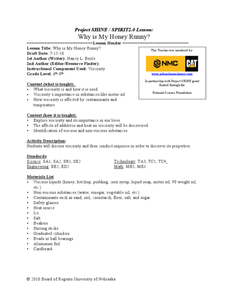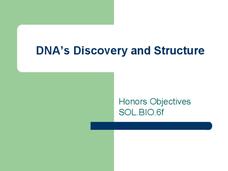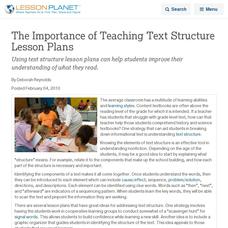Curated OER
What Do Scientists Do?
Middle schoolers do a report on distinct scientific fields using the Internet resources provided. They see the connection between what they learn in the classroom and what goes on in the enterprise of science.
Curated OER
What's All the Fuss?
Students investigate why air quality is important. In this environmental instructional activity, students research air quality and create an infomercial that explains why air quality is important. Students use video cameras to record...
Curated OER
Science Experiments - The Low-down
Third graders discover the process thinking about science experiments, and why they are important. They work in small groups using incline planes and a small toy car to design one scientific question that can be answered through...
Curated OER
Fossil Fuels-Importance and Formation
Student is introduced to the concept of energy as a common factor among all things. They list three fossil fuels and describe how fossil fuels were formed. They then tell how much plant debris it took to form one foot of coal.
Curated OER
HOW SMALL AM I? THE SCIENCE OF NANOTECHNOLOGY
Young scholars study nanotechnology and investigate the dimensions of a nanoscale. In this nanometer study lesson students will see how truly small a nanometer is by measuring things such as a piece of hair.
Curated OER
Why is My Honey Runny?
Students identify the factors that affect viscosity of substances. For this chemistry lesson, students define what viscosity is in their own words. They give real world applications of viscosity.
Curated OER
What's in the Soil?
Second graders create stratified soil levels using pictures. In this earth science lesson, 2nd graders identify "artifacts" from 3 historic eras and divide them into 3 soil levels. Then they draw their own multi-level soil profile and...
Curated OER
What can I do?
Students identify feelings and explore positive ways to handle conflict. In this mental health lesson students discuss feelings and how to constructively handle them.
Curated OER
Do You See What I See?
Young scholars engage in a lesson that differentiates between right and wrong types of observations. In order to conduct the experiment they are provided with leaves and nameless objects with different designs. The two are compared and...
Curated OER
The Purpose of Each Part of a Plant
Beginning botanists can sketch the parts of a plant in individual boxes, or better yet, they can tape or glue actual plant parts in them. Beside each box are a few sentences with selected words left out. From the word bank at the bottom...
Curated OER
Magnetism
If you are looking for a concise set of slides dealing with the basics of magnetism, look no further. Each slide defines a different magnetism concept: poles, fields, atoms, currents, electromagnets, motors, and generators. The only...
Curated OER
You Are What You Drink!
Students explore water treatment systems. In this water conservation ecology instructional activity, students identify and explain several processes used for water treatment and define related vocabulary after listening to content...
Curated OER
The Science of Respiration and Blood Circulation
Fifth graders study how respiration and circulation are connected. In this respiratory lesson students complete several activities to better understand heart rate and carbon dioxide in the body.
Curated OER
DNA's Discovery and Structure
With a professional appearance, this presentation introduces advanced biology learners to the history and structure of the DNA molecule. The details included in this resource are definitely more in-depth than what you would expose a...
Curated OER
What Would You Do If?
Students investigate the concept of how nature needs to be conserved. They examine how man has had a positive and negative impact. Students work in teams to make up scenarios with problems and then propose environmental solutions.
Curated OER
The Importance of Teaching Text Structure Lesson Plans
Using text structure lesson plans can help students improve their understanding of what they read.
Curated OER
Teaching Science Process Skills
Teaching science process skills is a vital part of helping students become good scientists.
Curated OER
Quality of Life Investigations: Risk Reductions
Students participate in a discussion of recent environmental issues affecting their own community or ones nearby. In groups, they research the role of food additives and the purpose of adding them to foods. They also determine their...
Curated OER
The Science of Color
Students use the scientific method to explore how to make different colors with paint. They problem solve ways to darken and lighten colors without using black and white paint. Students hypothesize how to create new colors, and describe...
Curated OER
Energy Generating a Culture: Early American Coal Miners and Coal Mining Culture
Young scholars calculate how much coal they use based on their electric power usage. In this environmental science lesson, students trace the history of coal mining in US. They write a letter to USPS to encourage them to create coal...
Curated OER
What's the Main Idea?
Fourth graders comprehend what they are reading. An effective strategy for comprehension is summarization. They single out and explaining the main ideas of a passage. Students find a sentence or rewrite their own that covers...
Curated OER
Why Are Thinning Trees Important?
Students investigate thinning trees and why they are important to the forest. In this sustainable environment lesson, students role-play as if they are trees in the forest and simulate the overcrowding and inability to move spaces,...
Curated OER
What are rice farmers doing to help the environment with their water-filled rice fields?
Third graders research rice fields. In this rice fields lesson, 3rd graders discuss how fields contribute to the environment by providing an important food source for birds. They find the benefits of rice fields to water and soil as...
Curated OER
What Does My Bacteria Look Like?
Students identify Gram positive and Gram negative bacteria using staining techniques. Students research importance of identification of bacterial types in diagnosing bacterial diseases.























